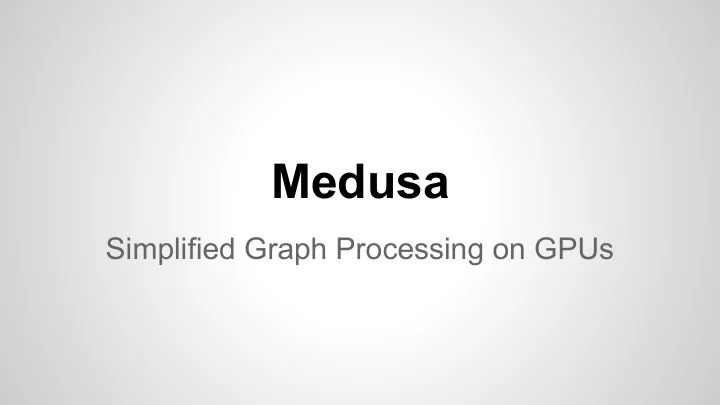

Medusa Simplified Graph Processing on GPUs
Motivation ● Graph processing algorithms are often inherently parallel ● GPUs consist of many processors running in parallel ● But… writing this code is hard
The Solution... ● Medusa is a C++ framework for graph processing on (multiple) GPUs ● Edge-Message-Vertex (EMV) programming model (BSP-like) ● Hides complexity of GPUs ● High programmability (expressive)
Related Work ● MTGL ○ Parallel graph library for multicore CPUs ● Pregel ○ Inspiration for the BSP model ● GraphLab2 ○ Finer-grained like EMV model ● Green-Marl
Design Goals ● Programming interface: ○ High “programmability” ● System: ○ Fast
Programming Interface ● User Defined APIs ○ Work on edges, messages, or vertices ○ The developer must provide implementations that conform to these interfaces ○ Where the algorithms themselves are specified ● System Provided APIs ○ Used to configure and run the algorithms
Example One user defined function: /* ELIST API */ struct SendRank { __device__ void operator() (EdgeList el, Vertex v) { int edge_count = v.edge_count; float msg = v.rank/edge_count; for (int i = 0; i < edge_count; i ++) el[i].sendMsg(msg); } /* VERTEX API */ struct UpdateVertex { __device__ void operator() (Vertex v, int super_step) { float msg_sum = v.combined_msg(); vertex.rank = 0.15 + msg_sum*0.85; } ...
System Overview
Graph-Aware Buffer Scheme ● Messages temporarily build up in buffers ● Problem: statically or dynamically allocate buffer memory? ● Best of both worlds: size based on max messages that can be sent along an edge. Reverse graph array avoids need to group messages for processing
Graph-Aware Buffer Scheme
Support for Multiple GPUs ● Graph partitioned for each GPU with METIS ● Vertices with out-edges crossing partitions must be replicated ● Dominates processing time ● Optimisation: replicate vertices n hops from replicated head vertices. ○ Replication only after n iterations, but now more vertices to process
Evaluation ● Single workstation with 4 NVIDIA GPUs ● 8 different sparse graphs ○ real-world and synthetic ● Tested against 3 types of state-of-the-art manual GPU implementations ● Tested against MTGL framework running on a 12-core CPU
vs Tuned Manual Implementation ● Tested against two different state of the art manual implementations ● Tested using BFS ● Medusa performance better on all but one graph ● Manual implementation techniques may not be applicable to Medusa if they hurt programmability
Simple Manual Implementation SSSP
vs Contract-Expand BFS Performance is variable depending on the graph when compare to Merril et al.’s recent work. Medusa Contract-Expand Hybrid Huge 0.1 0.4 0.4 KKT 0.4 0.7 1.1 Cite 2.7 1.3 3.0 Traversed edges, higher is better
Comparison with CPU Framework
Limitations/Criticisms ● No sophisticated support for distributed systems, e.g. failure handling (unlike Pregel) ● Limited justification for maximising “programmability” (many popular systems are simpler) ● No evaluation with different numbers of GPUs and numbers of hops to replicate
Conclusion ● Time will tell with the programming model ● Performance really depends on the graph/algorithm ○ Great vs CPUs! ● Interesting to combine the concept with other systems
Recommend
More recommend